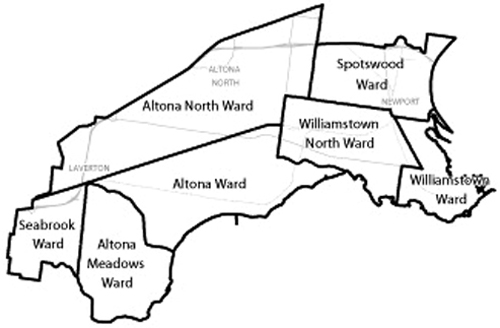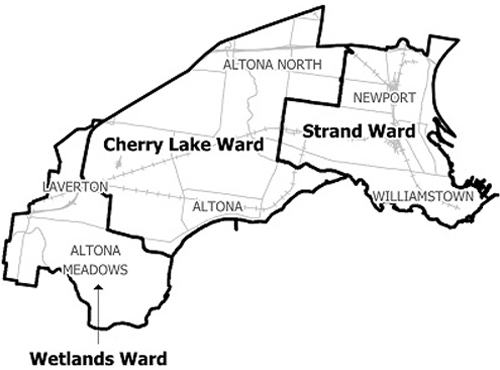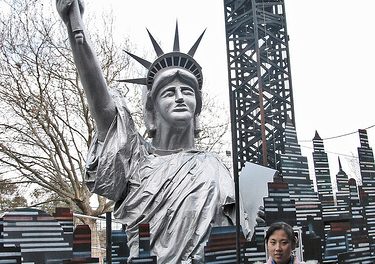Before the last Local Government Area election, the City of Hobsons Bay had 7 single-councillor wards shown in the map below:
- Williamstown (Angela Altair)
- Williamstown North (Peter Hemphill)
- Spotswood (Bill Tehan)
- Altona (Tony Briffa)
- Altona North (Michael Raffoul)
- Altona Meadows (Luba Grigorovitch)
- Seabrook (John Hogg)
There were two main problems with this partition:
- Some suburbs (e.g. Laverton) were split between 2 or more wards, causing confusion to residents.
- Suburb and ward names do not match e.g. the Seabrook Ward also included half of Altona Meadows suburb while the Altona Meadows Ward also included Seabrook residents.
Previous Altona North Ward councillor Michael Raffoul first raised in December 2011, the suggestion of multi-councillor wards to solve these problems. The then Altona Ward councillor Tony Briffa supported his proposal, saying: “I have always maintained that the electoral structure of a council should not divide communities of interest, and support the use of proportional representation in local government elections.” But Altona Meadows councillor Luba Grigorovitch said she preferred the existing structure. She said: “I think it’s good to know where our boundaries are. It gives more clarity to our constituents“. Williamstown Ward councillor Angela Altair agreed that the ward boundaries needed to be improved but said the single-councillor ward system had worked well so far. The vote to enter the submission eventually passed five to two, with Councillor Angela Altair and Peter Hemphill voting against the plan.
In its initial review, the Victorian Electoral Commission (VEC) preferred keeping the 7 single-councillor wards but in April 2012, recommended a 3-councillor ward (Strand Ward) and two 2-councillor wards (Cherry Lake Ward and Wetlands Ward), as shown in the map below. Basically, the 3 eastern wards (Williamstown, Williamstown North and Spotswood) are combined to form the Strand Ward. Altona merges with Altona North to form the Cherry Lake Ward while the Wetlands Ward is amalgamated from Altona Meadows and Seabrook wards. There are some changes in the boundaries but the total number of councillors remains at 7.
The voting was changed to a postal voting system and the following councillors were elected:
- Strand Ward (Angela Altair, Peter Hemphill, Paul Morgan)
- Cherry Lake Ward (Tony Briffa, Sandra Wilson)
- Wetlands Ward (Luba Grigorovitch, Colleen Gates)
Michael Raffoul probably did not expect his proposal would eventually turn out to be his nemesis. There may be 3 reasons why he failed to get re-elected to Council under the Cherry Lake Ward that he contested:
- The change from preferential voting in a single-councillor ward to proportional voting using the Single Transferrable Vote in a multiple-councillor ward may work to his disadvantage.
- He may have established a strong foothold in Altona North ward but he has not expanded his support base to Altona where he too needs to garner for votes under the new electorate structure.
- He has kept a low profile on the train issue in Altona. Tony Briffa and Sandra Wilson, who were elected, were both actively against the train service change. The Baillieu Government came to power largely due to voters’ dissatisfaction with the previous government’s management of public transport. I guess history may repeat itself in that voters would once again focus on public transport issues at the next state election. If politicians could sense the electorate mood, they should now actively engage with the constituents on these issues.
Upon reading about the new electorate structure from the local newspapers, what immediately sprang to my mind was the question: “How can this work?” What if the 2 or 3 elected councillors in the same ward happen to have very different personalities that clash?
I do not think there are any written rules or guidelines that govern how councillors from the same ward should work together. Hence they have two options: (A) collaborate with each other in the larger interest of the communities they jointly represent or (B) work independently of each other. Option A is ideally a no-brainer provided there exists an amicable relationship. In the perfect world, we would expect councillors to use their respective strengths to complement each other in producing a synergistic outcome much higher in quality than each individual would have achieved separately.
However, in the real world, there may exist several sources of conflicts of interests. In a load-sharing ward, how does each councillor claim ownership to efforts and achievements so that he/she can use these achievements to convince the constituents to re-elect him/her in the next election? The quest for credit may lead a councillor to adopt differentiation strategies that will put him/her in a more favourable light compared to others. In the situation where a councillor wants to assume the dominating leadership position and the other councillor does not want to give in, how to come to a compromise?
Councillors elected to the same ward may be unwilling bedfellows. They may belong to different political parties or hold different political beliefs, values and ways of doing things. Unlike a party in governance, they are not bound by a common charter or are required to adhere to any team rules. Neither is there a party whip to enforce discipline when differences and conflicts arise. One can hence see numerous examples of councillors squabbling with each other, requiring the intervention of VCAT for conflict resolution. The prognosis will probably be far worse if conflicts happen within the same ward rather than between different wards.
If Plan A does not work, the only option is Plan B which is not any easier. Under the old electorate structure, a councillor serves a smaller area. Now the number of constituents is doubled or tripled so it may not be feasible for a single councillor to cover the much expanded ward in the absence of load-sharing. Each councillor may not be able to give the best possible attention if he/she needs to service a much larger area. There will not be synergy and economies of scale if functions are being duplicated. Worse still, greater animosity may ensue if each candidate tries to undermine or pit against each other, in carving out his/her own local sphere of influence.
Now let us look at what are some of the “hot issues” facing each ward in Hobsons Bay. I will start with Cherry Lake Ward because I stay in this ward so I have a better knowledge of these issues either personally or through closely following media coverage.
Cherry Lake Ward
- Campaigning for improved train services
- Innova Toxic Soil Facility
- Fate of the former Altona West Primary School site
- Expanding the Altona Beach Nourishment program to western part of coastline
- Future directions of the Altona Beach Festival
- Tackling the seaweed problem in Altona
- Improving security in Pier Street and Harrington Square
- Altona Central Sports Precinct Plan
- Pier Street development
- Environmental pollution from the petrochemical industries
- Odour problem in Brookyln
- Burns Road land investment
- Insufficient childcare places
Strand Wand
- Redevelopment of the former Port Phillip Woollen Mills site in Williamstown
- Webb Dock expansion obliterating city view of Williamstown
- Fumigation facility in Spotswood
- Parking woes at Newport
- Revival of the Williamstown Festival
Wetlands Ward
As you can see, there is a long list of issues that the councillors need to work on and they can do them well only if they put aside any differences to fully concentrate on bringing out the best outcomes for the communities they serve.
Since the new electorate structure is already in place, we can only hope things will work out well. The worst scenario is VEC having to go back to the drawing board at the next election. However, four years is a long time so the impetus still falls on the collective wisdom and magnamity of the people’s representatives to iron out any problems.






